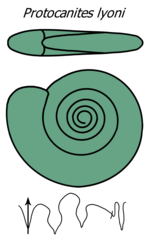Prolecanitoidea is a taxonomic superfamily of ammonoids in the order Prolecanitida. Prolecanitoidea is one of two superfamilies in the order, along with the younger and more complex Medlicottioidea. The Prolecanitoidea were a low-diversity and morphologically conservative group. They lived from the Lower Carboniferous up to the Middle Permian. Their shells are generally smooth and discoidal, with a rounded lower edge, a moderate to large umbilicus, and goniatitic to ceratitic sutures. Suture complexity varies from 10 up to 22 total lobes (each side of a whorl combined); new lobes are added from subdivision of saddles adjacent to the original main umbilical lobe.
| Prolecanitoidea Temporal range:
| |
|---|---|

| |
| Protocanites, a Tournaisian prolecanitid | |
| Scientific classification | |
| Domain: | Eukaryota |
| Kingdom: | Animalia |
| Phylum: | Mollusca |
| Class: | Cephalopoda |
| Subclass: | †Ammonoidea |
| Order: | †Prolecanitida |
| Superfamily: | †Prolecanitoidea Hyatt, 1884 |
| Families | |
| Synonyms | |
|
Prolecanitaceae | |

The Prolecanitoidea encompasses two related families, the ancestral Prolecanitidae (lower Tournaisian – Bashkirian? stages) and the derived Daraelitidae (Viséan – Wordian stages). Prolecanitids and daraelitids differ primarily in the complexity of the suture: Prolecanitids are simpler goniatitic forms, with rounded saddles, pointed lobes, and an undivided ventral lobe. Daraelitids, conversely, often have a trifid (three-pronged) ventral lobe and a higher number of lobes as a whole, some of which are ceratitic (finely serrated). Daraelitids are probably ancestral to Ceratitida, the dominant order of Triassic ammonoids.
A third proposed family, the Mississippian-age Prodromitidae, is occasionally also placed within the order Prolecanitida.[1] The affinities or monophyly of this family are uncertain due to drastic changes in their suture patterns through ontogeny. More recently, prodromitids have been moved to the goniatite suborder Tornoceratina.[2]
The Prolecanitoidea were previously known by the name Prolecanitaceae, prior to the recent ruling of the ICZN regarding superfamilies. The suffix -oidea was previously used for some time in invertebrate taxonomies as the ending for subclasses, e.g. Ammonoidea. The Medlicottioidea are also sometimes known as the suborder Prolecanitina.
References
edit- ^ Work, David M.; Mapes, Royal H.; Thompson, Thomas L. (1988). "A New Prodromitid Ammonoid Genus from the Hannibal Shale (Lower Mississippian) of Missouri". Journal of Paleontology. 62 (5): 772–778. ISSN 0022-3360. JSTOR 1305399.
- ^ Work, David M.; Mapes, Royal H. (2002). "Morphological and taxonomic clarification of the lower Mississippian (Kinderhookian) ammonoid genus Eoprodromites". Journal of Paleontology. 76 (5): 910–912. doi:10.1666/0022-3360(2002)076<0910:MATCOT>2.0.CO;2. ISSN 0022-3360.
- Furnish, William M.; Glenister, Brian F.; Kullmann, Jürgen; Zhuren, Zhou (2009). "Ch. 4 (in part): Prolecanitida". In Selden, Paul A. (ed.). Part L, Mollusca 4 (Revised). Volume 2: Carboniferous and Permian Ammonoidea (Goniatitida and Prolecanitida). Treatise on Invertebrate Paleontology. Lawrence, Kansas: The University of Kansas Paleontological Institute. pp. 185–192. ISBN 978-1-891276-61-3.
- Miller, Furnish, and Schindewolf, 1957; Paleozoic Ammonoidea, esp. superfamily Prolecanitaceae, L69, in The Treatise on Invertebrate Paleontology, Part L, Ammonoidea.
- Saunders and Work; Abstract: Evolution of shell morphology and suture complexity in Paleozoic prolecanitids... [1]